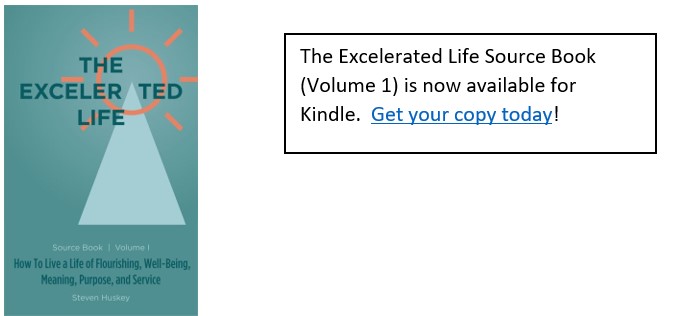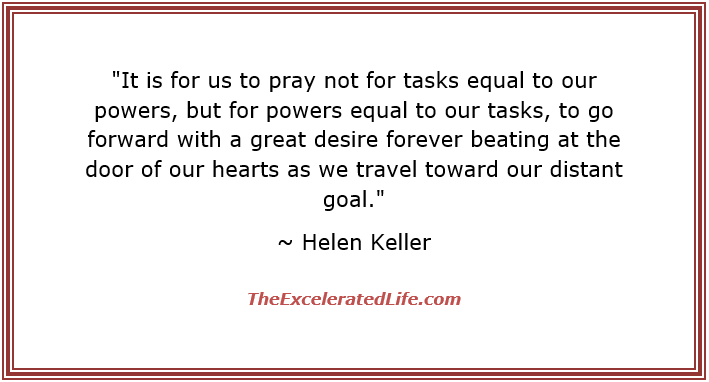Pursuing a worthy goal gives you a sense of purpose. It boosts your self-esteem and self-confidence. Working toward a goal adds structure and meaning to life and gives you the opportunity to practice setting priorities and managing your time well. Finally, a happiness goal usually involves engaging with others, which can bring happiness in and of itself.
Finding Happiness
A large group of people attended a presentation on happiness. As they checked in, each attendee was given a balloon and a marker and instructed to write his or her name on the balloon. Then the balloons were collected and placed in a separate room.
The group gathered in the presentation room and were given these instructions: Go into the room filled with balloons and find the one with your name on it. And, by the way, you have 10 minutes.
All the participants entered the balloon room and begin frantically pushing through all the balloons, looking for the one with their name. The room erupted in chaos, with people pushing past each other, colliding with one another, and in general, causing mayhem.
After 10 minutes, the leader called a halt to the activity. She collected all the balloons and put them back in the room. This time the attendees were instructed to pick up any balloon, find the person whose name was written on it, and give the balloon to that person. Within a few minutes, everyone had their own balloon.
The speaker said, “This is a good illustration of what is going on in most of our lives. Everyone is frantically searching for happiness all around, not knowing where to find it. But our happiness lies in the happiness of other people. Help give them their happiness and you will find your own.” [1]
Choosing Happiness Goals
I studied life coaching with Dr. Dianne Greyerbiehl, founder of The Life Coaching Institute in Greenville, SC. During my time there, Dr. Greyerbiehl formalized a transformational coaching model that incorporated Appreciative Inquiry.
Dr. Greyerbihl called her coaching model Insight Transformation. A major part of this model was helping clients choose “happiness goals”. Dr. G wrote this about the link between having a goal and improving positivity (which she termed happiness):
“Help the client fill out a goal or goals for a daily happiness program. The happiness program can be a fourth goal on which the client will work and/or could be incorporated into action steps for the other goals.”
“Remember there is a direct link between good goals and happiness. Goals create meaning in our lives, help structure our time and prioritize our activities.”
Any properly configured goal helps improve feelings of positivity and well-being. In addition, one can set a goal with the specific end in mind of increasing “happiness”.

Why Choose Happiness Goals?
Let’s first be clear about what we mean by happiness.
Happiness: The experience of joy, contentment, and positive well-being, combined with a sense that life is good, meaningful, and worthwhile; also Subjective well-being or positive emotion or positivity – pleasure + meaning + purpose.
Happiness, as we are using it today, goes beyond good feelings and pleasure. It includes well-being and flourishing; living a life of meaning, purpose, and service.
In the early days of Positive Psychology (and my studies with Dr. G) happiness and positivity were used almost synonymously. Over time, the concept of happiness vs. positivity was refined to more clearly focus on the aspects of positivity, which include and go beyond mere happiness.
These are the components of positivity and well-being as defined by Dr. Martin Seligman, the “father” of Positive Psychology: positive emotion, engagement, meaning, positive relationships, and accomplishment. [Seligman] It’s important to note that each of the five components is pursued for its own sake. And each element is defined and measured independently of the other elements.
The goal of happiness is to increase life satisfaction. This is a difficult thing to measure because it is subjective and is greatly influenced by the mood you happen to be in. But the goal of well-being is to increase flourishing by increasing one or more of the 5 measures.
Having a goal to work for provides a sense of purpose and a feeling of control over our lives. It bolsters self-esteem, self-confidence, and the feeling of being useful and effective. It adds structure and meaning to daily life and helps us to master our time and set priorities. Commitment to a goal can help us cope better during times of crisis. And pursuing a goal often involves engaging with other people, which can bring happiness in and of itself.
What To Include In A Happiness Goal
Research shows that some goals are more likely to improve well-being and a feeling of positivity. These are the points to keep in mind when you are choosing your happiness goals.
Choose intrinsic goals. Intrinsic goals are those that are personally rewarding to you. They bring fulfillment and meaning to your life. Extrinsic goals are chosen for you or chosen by you because someone else wants you to have the goal. Intrinsic goals are inherently satisfying and lead to a larger payoff in terms of happiness.
Choose authentic goals. These are the goals that you value and “own”, as opposed to goals that you set because of the expectations of others (parents, spouse, friends, society). Choose goals that fit your values and strengths.
Choose approach goals. Approach goals are goals that have you working toward a positive outcome. This is in contrast to avoidant goals, where you are avoiding a negative outcome. Approach goals promote well-being; avoidant goals can detract from happiness.
Choose harmonious goals. It is important that your goals complement each other. You may be able to change your method of pursuing each one so that they are in harmony overall. You may need to give up one or the other or run the risk of losing both.
Choose activity goals. Seeking to improve your circumstances (bigger house, bigger car, bigger TV) has been shown to be a difficult route to improved happiness. Activity goals allow you to meet new challenges, take advantage of new opportunities, and have a variety of experiences.
How to Experience the Benefits of Happiness Goals
Any goal can improve positivity levels if it meets the criteria for a happiness goal. Following these steps will demonstrate how your positivity increases by pursuing a specific “happiness” goal.
- Take the Subjective Happiness Scale assessment.
- Select a goal or goals for a daily happiness program. For ideas, see the suggestions in The Happiness Hundred. (Specific instructions for setting and pursuing a goal are included below.)
- Do a step of your goal every day.
(Remember, this can be a process goal, not an outcome goal, such that you focus on the process – the journey – not the ultimate destination.) - After a period of time, 4-6 weeks, take the SHS assessment again to see if your score has improved.
What Do I Do Now?
These are some of the benefits of committed goal pursuit.
- Provides a sense of purpose and a feeling of control over our lives.
- Bolsters self-esteem, self-confidence, and the feeling of being useful and effective.
- Adds structure and meaning to daily life.
- Helps us to master our time and set priorities.
- Commitment to a goal can help us cope better during times of crisis.
- Often involves engaging with other people, which can bring happiness in and of itself.

Here are recommendations for committed goal pursuit.
- Generate a list of desires, intentions, and aspirations.
- From this list, identify your highest priority goals. Examine the goals and assess how much effort it will require, what resources (money, time, people, etc.) are needed, and what achieving the goal will mean to you.
- Select one goal from your list of high-priority goals. Write it down. Commit to achieving the goal.
- Break the goal down into small, discrete action steps. As you think of the actions you will take, anticipate any obstacles that you might encounter and plan how you will manage them.
- Begin on the first action step right away. Start while your motivation is high and let it move you through the first steps. As you complete more and more of the steps toward your goal, inertia will help keep you moving toward completion.
The Goal Achievement Excelerator provides in-depth, detailed instructions for selecting and achieving meaningful and worthwhile goals. It isn’t a quick process but many find it well worth the time and effort.
Choose a Happiness Goal
Remember the benefits of committing to a goal. Pursuing a worthy goal gives you a sense of purpose. It boosts your self-esteem and self-confidence. Working toward a goal adds structure and meaning to life and gives you the opportunity to practice setting priorities and managing your time well. Finally, a happiness goal usually involves engaging with others, which can bring happiness in and of itself.
Here are guidelines for seeking healthy goals:
- Strive for enjoyable goals.
- Develop both short- and long-term goals.
- Seek out goals you value.
- Change your goals if they are not working.
- Focus on goals that increase happiness and well-being in terms of orientation, content, and motivation.
There is a Chinese saying that “If you want happiness for an hour, take a nap. If you want happiness for a day, go fishing. If you want happiness for a year, inherit a fortune. If you want happiness for a lifetime, help somebody.” Other thinkers and philosophers have suggested the same thing: Happiness is found in helping others.
So when you’re searching for the “happiness balloon” with your name on it, think about setting a goal that has you reaching out to others. Choose a happiness goal. That is embracing your Excelerated Life™!
What is your experience with setting goals?
Did you notice an improvement in your positive outlook?
Share your thoughts by leaving a comment below.
Excelerated Goal Setting™ — planning and achieving BIG (Bold, Important, Gratifying) goals — is one step in creating your Excelerated Life™, a life of flourishing and well-being, and a life of meaning, purpose, and service.
Read more about the Excelerated Life™.
Footnotes:
[1] Adapted from “7 Short Stories On Happiness And Contentment.”
moralstory.live/2021/01/Short-Stories-On-Happiness-And-Contentment.html
Resources:
Seligman, Ph.D., Martin E. P. Flourish. New York: Free Press, 2011.


